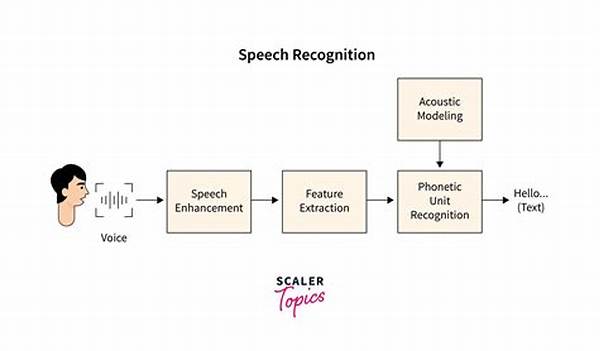Real-Time Speech Recognition Technology
In today’s fast-paced world, communication is king, and the ability to interpret spoken language quickly and accurately is no longer just a novelty but a necessity. Enter real-time speech recognition technology, a tool that is transforming the way we interact with our devices, each other, and the world around us. Imagine sitting in a bustling café, chatting with friends in different languages, and effortlessly transcribing your entire conversation into text in real-time. Sounds like magic? Well, it’s more reality than fantasy, thanks to advances in this incredible technology.
Real-time speech recognition technology revolves around algorithms and machine learning models designed to understand and convert human speech into text instantly. This technology is everywhere: from virtual assistants like Siri and Alexa to advanced customer support systems. It reduces the need for keyboards and touchscreens, making interactions more natural and intuitive. Whether you’re a busy professional dictating emails, a student taking lecture notes, or a traveler navigating a foreign country, this technology is at your fingertips, ready to simplify your life.
However, the real charm of real-time speech recognition technology lies in its versatility and potential for future growth. Industries from healthcare to automotive have harnessed its power to improve efficiency, accuracy, and customer satisfaction. Think about a doctor who can now update patient records verbally while maintaining eye contact with their patient, or a driver whose hands remain safely on the wheel while navigation instructions are dictated by the onboard system. The possibilities are as vast as they are exciting.
While the potential is enormous, so are the challenges. Accents, dialects, background noise, and multiple languages pose significant hurdles. But with rapid advancements in artificial intelligence and neural networks, these challenges are swiftly being overcome. It’s not just about making technology work; it’s about making it work for everyone, everywhere. Stay tuned, because the future has just arrived, and real-time speech recognition technology is leading the charge.
Exploring the Applications of Real-Time Speech Recognition Technology
As we continue to integrate real-time speech recognition technology into our daily lives, its applications grow exponentially. One of the most significant uses is in accessibility, providing opportunities for individuals with disabilities to interact with technology seamlessly. For example, voice-activated systems can empower visually impaired users to navigate digital interfaces effortlessly or enable those with mobility challenges to control smart home devices by voice command.
In business settings, real-time speech recognition technology enhances productivity and innovation. Virtual meetings can now be transcribed live, capturing crucial discussion points instantly. This not only saves time but also improves accuracy in information sharing and decision-making processes. Moreover, companies are leveraging this technology in customer service to offer 24/7 assistance without the need for human staff during odd hours.
But it’s not just businesses reaping the rewards. The educational sector, too, is witnessing revolutionary changes. Real-time speech recognition aids in creating inclusive classrooms where language barriers are minimized. Students can receive real-time translations, participate actively, and feel included regardless of their native language. The real-time transcription of lectures also ensures that important academic content is accessible to all students, including those with hearing impairments.
It’s fascinating how this technology is bridging gaps and paving the way for a more connected and inclusive society. As advancements continue and real-time speech recognition technology becomes more sophisticated, we can expect even greater accessibility, productivity, and innovation across all sectors.
What Makes Real-Time Speech Recognition Effective?
In dissecting why real-time speech recognition technology has become so effective, we must recognize several factors at play. Primarily, the continuous improvement of AI and machine learning algorithms has significantly boosted the accuracy of voice recognition systems. These advancements enable the technology to better understand and adapt to varying speech patterns, dialects, and even emotional tones.
Moreover, the availability of massive datasets for training these algorithms has been pivotal. By learning from a diverse range of voices and languages, the technology becomes more comprehensive in its applications. It no longer struggles with understanding heavily accented speech or picking out voice commands amidst background noise, meeting user expectations with impressive accuracy.
What’s perhaps most remarkable about real-time speech recognition technology is its ability to learn on the fly. It can adapt to new terminologies, slang, and user-specific phrases, which ensures that the technology stays relevant and practical. This adaptability enhances user experience, ensuring the system delivers optimal performance regardless of the complexities of human language.
Examples of Real-Time Speech Recognition Technology Usage
The Future of Real-Time Speech Recognition Technology
As we peer into the future, the potential for real-time speech recognition technology continues to expand. Its integration into various facets of life and business promises to streamline operations and enhance user experiences. One area of exciting growth is the field of augmented reality (AR). When combined with AR, speech recognition can power applications that overlay translations on real-world objects or provide spoken guidance in rich, interactive environments.
The entertainment industry, too, is poised to benefit. Picture a world where movies and TV shows can adapt dialogue to the viewer’s chosen language preference in real-time, without missing a beat. This adaptability would revolutionize media consumption and break down language barriers worldwide.
Furthermore, the role of real-time speech recognition in social justice cannot be overlooked. By democratizing access to information and technology, it stands to be a powerful tool in reducing inequalities, offering equal opportunities for education and employment irrespective of language proficiency.
In conclusion, as developers continue to innovate and enhance the capabilities of real-time speech recognition technology, the future is full of promise. It will be exciting to witness how this technology evolves, reshaping industries and altering the fabric of communication across the globe.
—
These sections collectively explore the transformative potential of real-time speech recognition technology, presenting its applications, effectiveness, current uses, and future possibilities in a comprehensive and engaging manner.

